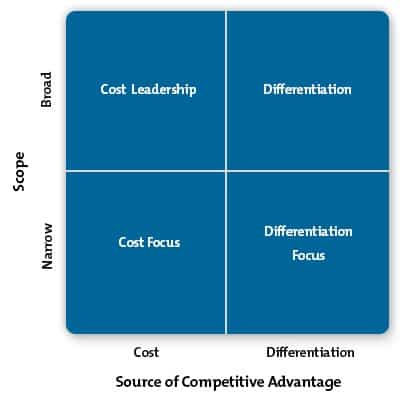Introduction
The company has been offering pizza and other food items to the customers. The company was a success story with 50 outlets established in the country. The company has also seen growth of the revenue levels in the past. However, all these aspects were changed due to the changeover of the Chief Executive Officer (CEO); the eventual results were negative and the company could not achieve the intended long-term benefits. Pizza Place also has seen many employees leaving the company as they are not satisfied with the quality of services they are receiving. Thus, the positive scenario and the growth the company had achieved in the past was changed due to new hierarchical policies introduced by the new management.
It is important to analyze the company based on Porter’s generic strategies model. This model will indicate as to how the strategies will need to be formulated and used in the future context (Tanwar, 2013). The development of the appropriate strategies will allow the organizations to be able to make sure they develop the needed advantage and offer the values in line with the expectations of the customers.
Figure 1 – Porter’s Generic Strategies (Ogola, 2005)
The company has focused on offering the customers value for money; this, in other words, highlights that the products offered to the customers have cost as the competitive advantage. On the other hand, the overall scope is broad and the cost leadership strategy is maintained by the companies. Thus, the key strategy is the cost leadership. This means they have to develop all other strategies to match the cost leadership approach that is in place.
New changes and impact
The new changes were naturally carried out with a view to standardizing the services and to improve the quality and the consistency of the services provided. The steps taken were highly short-term profit-oriented. The employee empowerment that had existed to customize the services was stopped. The employees now have to adhere to a strict set of expectations in terms of the services consistency. This is contrary to the services that have been enjoyed by the customers. It is possible that the employees were treating the customers with a certain personal and customized approach. Due to the standardization of the services, the customers might have felt that this had changed.
The employee empowerment as well as the financial and non-financial benefits provided to them are the main motivating aspects. Herzberg’s two factor theory indicates the factors that will motivate the employees and what other factors will act as satisfiers (Dobre, 2013; Ganta, 2014). In this instance, the satisfiers as well as motivators have been violated and the result was negative in all respects.
Figure 2 – Herzberg’s two factor theory (Waheed, 2011)
The employees have been assigned extra tasks; these include strict training, tests and failure resulting in the employees having to leave the company. This is likely to be a major challenge for the employees and they will not be able to reach the intended results as a consequence. Further, they are asked to carry out the janitorial services. All these aspects indicate that the employees are demotivated to work in the company. On the other hand, the employees were satisfied with the benefits with which they had been provided (Amponsah-Tawiah, 2015). They received financial as well as non-financial benefits from the company. That has also been prevented with these steps that they have taken.
Thus, the above indication identifies that the employee motivators as well as the satisfier factors have been violated. The eventual result in this context is that the employees are demotivated, and this leads to the employee performance issues. The overall employee commitment level tends to be low in this respect and could create many long-term issues as a result.
Motivating the young staff
It is important to use appropriate motivational models that will indicate as to which strategies should be used in the context of employee motivation. The previous discussion used Herzberg’s model for evaluating the impact on the motivation (Osabiya, 2015). In this instance a mixed approach using the previous discussion and Maslow’s hierarchy of needs could be used. The following diagram indicates the model.
Figure 3 – Maslow’s hierarchy of needs (McLeod, 2017)
The above model highlights that in order to motivate the employees, appropriate steps have to be taken to provide them with the benefits they are in need of.
The team at Pizza Place consists primarily of young people who seek motivation to improve the results they bring to the company. The company is already paying these employees a higher salary, and this means the financial incentives might not be adequate to satisfy them in an overall context.
One of the key aspects is the social needs; catering to the social needs will allow the youth to interact with each other and know what they have to do to reach the long-term benefits they seek. Thus, one of the ways of motivating the employees is holding events where the employees can interact with each other and enjoy themselves. Organizing off-side training and knowledge sharing programs with a bit of fun activities will allow the company to reach these targets well.
Another approach the company could use is to motivate the teamwork; the youth would like to work as teams and perhaps the team that performs the best should be given a foreign tour. This will motivate the employees to improve their performance and ensure that they work to improve the overall satisfaction levels of the employees.
Another method is employee empowerment; for instance, the employees would like to achieve, and getting them engaged in the target setting process is likely to be positive in this regard. Now that they have the ability to work with the decision making related targets, they will feel that they are more accountable to the outcomes affiliated with the organizations. This will lead them to achieve better levels of results in the future context.
Thus, the eventual result is likely to be positive and the employees will now work with more focus and have a sense of needing to achieve the expected long-term results in the future context.
Development of programs to regain the market position
The company has changed from a relationship-oriented approach to more of a standardized approach of services. The result was the company losing employees. The company will now have to revert back intensively towards the relationship-oriented approach and ensure that they continue to provide the service quality they have been providing to the customers.
Short-term – The purpose is to attract the customers the company has lost.
- The company should look to enhance the relationships they had with the customers; thus, they should provide an extra special promotion and discount package to the former customers. The company should identify the long-term customers and they should be provided with these benefits. Thus, they will be able to enjoy a set of beneficial results through the program.
- The company also should collect the proposals of the employees and make sure that they work with the employees to improve the overall service quality of the organization. These immediate changes will attract at least a part of the customer base the company has lost.
- The company should again outsource non-core activities such as janitorial activities etc. These will enhance the values that they are offering to the customers and then ensure the benefits are in line with the expectations of the customers. The long-term benefits can be achieved as a result.
Medium-term – The purpose is to stabilize and grow the operations at this stage.
- In this instance, the company is seeking to develop programs that would motivate the employees and the teamwork affiliated with the companies. Thus, the employee, knowledge sharing, recognition and holidays programs should be developed.
- The company also has to identify the specific needs of the customers. These may include more items in the menu, health food items and other such aspects that they will need. Thus, the services they offer have to be modernized to meet the new customer expectations.
- The company also has seen the need for an expansion of the number of outlets that they have. Thus, expansion of the outlets will benefit them and make sure that they will be able to provide the customers with the positive results in the future.
Conclusion
Thus, the above discussion related to Pizza Place indicates that they had been able to improve the quality of the operations and achieve market expansion in the past. The wrong decisions taken by the leadership had eventually created a high level of demotivation and caused the employees to leave the company. The customer dissatisfaction was the result and they had to work towards improving the customer satisfaction levels in the future context. All these aspects highlight the need for changing the policies of the management and working to improve the employee motivation levels. Thus, the eventual performance of the company will see better levels of improvement.
References
Amponsah-Tawiah, E. K.-M., (2015). Employee Motivation and Work Performance: A Comparative Study of Mining Companies in Ghana. Journal of Industrial Engineering and Management, 9 (2), 255-309.
Dobre, O.-I., (2013). Employee motivation and organizational performance. Review of Applied Socio- Economic Research, 5 (1), 53-60.
Ganta, V., (2014). Motivation in the Workplace to Improve the Performance. International Journal of Engineering Technology, Management and Applied Sciences, 2 (6), 221-230.
McLeod, S., (2017). Maslow’s Hierarchy of Needs. Retrieved May 15, 2018, from Simply Psychology: https://www.simplypsychology.org/maslow.html. [Accessed May 15, 2018].
Ogola, M., (2005). Application of Porter’s Generic Staregies by Insurace Companies in Kenya, http://erepository.uonbi.ac.ke/bitstream/handle/11295/23041/Ogolla_Application%20of%20porter%E2%80%99s%20generic%20strategies%20by%20insurance%20companies%20in%20Kenya.pdf?sequence=3&isAllowed=y. [Accessed May 15, 2018].
Osabiya, B., (2015). The effect of employees’ motivation on organizational performance. Journal of Administration and Policy Research, 7 (4), 62-75.
Tanwar, R., (2013). Porter’s Generic Competitive Strategies. Journal of Business and Management, 15 (1), 11-17.
Waheed, T. H., (2011). Herzberg’s motivation-hygiene theory and job satisfaction in the Malaysian retail sector: the mediating effect of love of money. Asian Academy of Management Journal, 16 (1), 73-94.




One comment